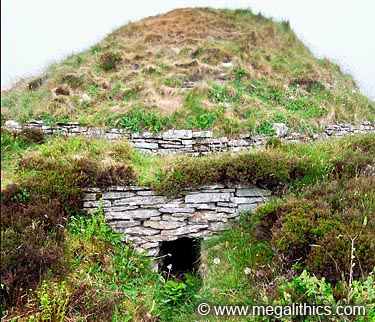
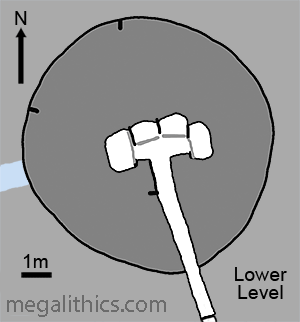
 |
 |
|
More Photos |
|
|
VR Tour |
||
|
|
3D Vision |
||
|
|
Infrared |
||
|
|
Lady Burroughs' Sketches | ||
|
|
Finds |
| HY 42585 27600 (GPS 22min) | Cairn (outer wall facing) c9m (Pub.) |
| Visited June 2008 | Alt. 71m OD (upper entrance) |
Taversoe Tuick (ORK 49) is a partially restored Orkney-Cromarty type chambered cairn with an unusual internal structure, it is located on the south coast of Rousay, which is one of the central Orkney islands. The cairn is situated very close to Trumland House on an elevated site with marvellous views (when it is not foggy or raining!) to the south over Eynhallow and Wyre Sounds to Wyre and Orkney Mainland.
Prior to 1898 the existence of Taversoe Tuick was unknown, the site appearing to be a simple grassy knoll known as Flag Staff Hill in the grounds of Trumland House. As mentioned above, the knoll has excellent views to the south, and in 1898 the owner of Trumland, Lt. Gen. Traill Burroughs, decided to site a summer seat there. He had a wedge dug into the south side of the knoll to serve as a wind shelter for the seat and when the digging neared the north face of the mound a rough stone wall was revealed. As further stone structures appeared it became apparent the mound was actually a "Pict's House" ( chambered cairn ), at which point Gen. Burroughs proceeded to excavate the entire tomb himself. Initial accounts of the discovery of the tomb were restricted to local newspapers (1,2) and the private journal of Lady Eliza Burroughs (see later), but the first formally published account of the excavation was not until that of Turner (3) in 1903. Whilst being quite detailed, Turner's publication was completely based on accounts of the excavation contained in letters to him from Lady and Gen. Burroughs, and it only included a plan of the lower chamber.
The cairn was re-excavated in 1937 by Walter Grant on behalf on the Ministry of Works. Grant's (4) investigations were more thorough than those of Burroughs and he planned and confirmed the presence of an upper chamber to the tomb as well as discovering the miniature subsidiary chamber to the SE of the main cairn. At the time, Grant was the owner of Trumland House and when excavation was complete he erected the protective concrete dome over the cairn and then gave the monument into State Guardianship.
An extract from Lady Burroughs journal covering the discovery and exploration of the tomb was eventually published in 1985 (5), as well as making fascinating reading, this charming document has some excellent pencil sketches of the tomb as it was revealed during the phases of digging (see separate section).
The most complete general account of the monument is probably that in Davidson and Henshall's "Chambered Cairns of Orkney" (6) which is an update and expansion of part of Henshall's earlier, monumental ( sorry, but it is! ) work "The Chambered Tombs of Scotland".
Taversoe Tuick is an unusual monument for several reasons, but
probably the most striking is its dual level construction, only one other Orkney
tomb shares this structure, Huntersquoy (ORK23) on the island of Eday. The floor
of the upper chamber at Taversoe is formed by the roof lintels of the lower,
when the cairn was intact there was no communication between the two chambers,
each having its own entrance passage on opposite sides of the cairn. It is
tempting to see the twin chamber arrangement as evidence suggesting a
multi-phase monument, but it is currently believed that the cairn was
deliberately built this way in one round of construction.
It is also interesting to speculate that there may have been segregation of
deposition between the two chambers, certainly selective deposition based on sex
or age has been discovered at other British chambered tombs of similar date.
Unfortunately the destruction of most of the upper chamber at Taversoe means
there is not enough material to test this hypothesis, but only cremated bone was
recovered from the upper chamber and only unburnt skeletons found in the lower
(some cremated bone found in lower entrance passage).
The lower chamber is definitely of the "Bookan" type, the cells being segmented by vertical slabs around a central space. In the upper chamber the vertically set stones hardly protrude into the chamber space, the cells being much more defined by walling than segmenting slabs. The lower chamber strongly resembles that found at Huntersquoy, although there was only one "bench" cell facing the entrance passage in that chamber.
Another unusual feature at Taversoe Tuick is the miniature subsidiary chamber discovered to the SE of the main cairn, completely subterranean, this arrangement is unique amongst the Orkney Cairns currently known. The chamber is certainly part of the original cairn construction as a continuation of the entrance passage to the lower chamber is extended downhill to meet it. Strangely, this passage extension, although roofed with lintels for much of its length, shrinks in size as it approaches the subsidiary chamber becoming only 6cm wide towards the end. This unusual construction has been called a drain, but this obviously not what it was intended to be.
All in all, a unique and puzzling monument.
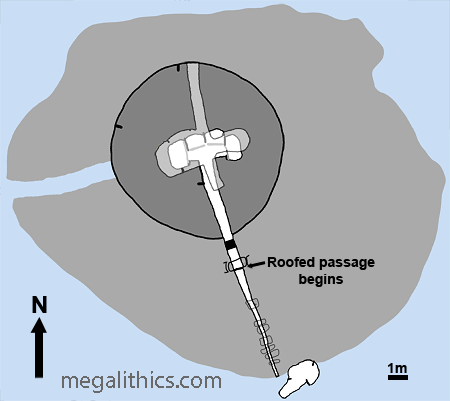
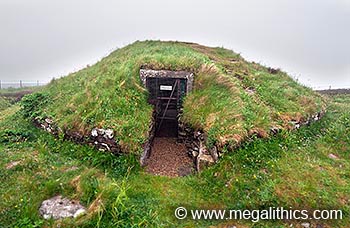 The cairn has a diameter of around 9.2m and
is faced on all sides by several courses of drystone work extending up to 50cm
above ground. Two upright slabs were found inserted in this wall face, one on
the NW, and a second at the north, just west of the upper chamber passage entrance. The second
stone marks the edge of a 45cm recess formed in the west edge of the
entranceway, the purpose of the recess is unknown, but it had been filled in
with loose masonry.
The cairn has a diameter of around 9.2m and
is faced on all sides by several courses of drystone work extending up to 50cm
above ground. Two upright slabs were found inserted in this wall face, one on
the NW, and a second at the north, just west of the upper chamber passage entrance. The second
stone marks the edge of a 45cm recess formed in the west edge of the
entranceway, the purpose of the recess is unknown, but it had been filled in
with loose masonry.
Because of the damage to the upper part of the cairn there is no estimate for its original height when intact, but the knoll was said to be around 1.4m tall before work on the summer seat began.
The roofed section of the lower chamber entrance passage extends SE1.6m beyond the margin of the cairn, the entire fabric of this protrusion is currently below the lowest visible course of retaining wall directly above it. This extension is built of drystone work and is returned about 50cm on either side of, and above, the opening, forming a second, lower, wall face that is concentric with the cairn.
The cairn proper is surrounded by a "platform" formed by loose laid flat stones, this is irregular in shape and extends between about 3m to 7m from the cairn margins. There is a clear "path" through the platform stones at the west, this bordered by boulders and runs through the whole width of the platform terminating at the cairn's retaining wall. Curiously, the end of this "path" is nowhere near either of the two chamber entrances.
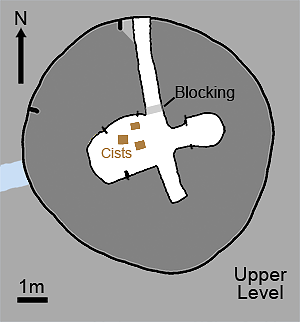
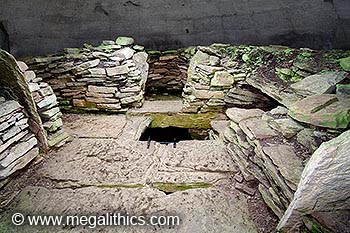 The upper chamber structure
sustained substantial damage during the digging out of an alcove for
the planned summer seat prior to the discovery of the monument. The damage to
the south was so severe that only two courses of the chamber walling survived
here at the time of Grant's excavation. So when viewing
our photos, bear in mind that the SW section of the present upper chamber is
largely comprised of "restored" stonework.
The upper chamber structure
sustained substantial damage during the digging out of an alcove for
the planned summer seat prior to the discovery of the monument. The damage to
the south was so severe that only two courses of the chamber walling survived
here at the time of Grant's excavation. So when viewing
our photos, bear in mind that the SW section of the present upper chamber is
largely comprised of "restored" stonework.
The entry passage into the upper chamber is at the north of the cairn, it is 3.4m long and 0.5m wide. As mentioned above, the passage has a 0.45m recess on its western edge which is delimited an upright slab set into the cairn's retaining wall. The passage stonework has a maximum surviving height of 0.9m, with no trace of roofing extant its original height is unknown. A narrow section of blocking was found at the very inner end of the passage.
The upper chamber and passage form a rough cruciform shape, the chamber having three distinct areas, or compartments. The largest area is at the west and measures around 2m x 2.8m, the north wall contains two vertically set slabs and the south one, although this stone was found in the debris and inserted to fill an empty slot found there. This compartment is floored by the western two lintels and during the Burroughs excavation was found to contain three stone cists, they measured about 0.45m by 0.6m and all were complete with capstones. The cists are shown in the diagram on the left, the positions taken from a pencil sketch done by Lady Burroughs.
The second largest compartment is at the east, this is "horseshoe" shaped space 1.2m wide and 1.3m deep, with a short entrance passage that has vertical portal stones set into the masonry at its end creating an aperture about 0.75m wide. At present the walling of the chamber is around 1m tall at the area of the portal stones which themselves are 0.8m and 1m tall. The masonry of the walls corbels in over the interior of this compartment producing a maximum overhang of 0.3m. Because of thickness differences in the lintels on which the upper chamber is built, the floor in the east compartment is 0.2m lower than the rest of the chamber, Grant (4) found that a layer of clay had been used to bring this floor into level with that of the chamber as a whole. The clay layer was an original feature of the construction as Grant found that it ran beneath the masonry of the east chamber walls. At the Huntersquoy cairn, clay had been used to form an entire floor for the upper chamber, but here it seems to have been used only in the eastern chamber.
The final compartment of the upper chamber is directly opposite
the entrance passage and in plan, looks almost like a continuation of it. The
space is 0.6m wide and straight-sided, it is roofed with lintel stones and is
0.7m tall, it runs for 1.4m. The walls are plain drystone work with none of the
vertically set slabs seen in the other two spaces. This space and the entrance
passage both partially use the central lintel for their flooring so both ends of this
lintel were left exposed, the ends of the other four lintels are all
buried under the cairn structure. In this compartment, the central lintel
provides the flooring for the first 0.5m, the remainder is provided by the
lintels of the lower chamber entrance passage. The passage lintels are set
considerably lower than the upper chamber floor and even though the floor in the
compartment was covered in debris, the downstep at the lintel end was noticeable
during our visit.
There is some confusion between the accounts of Turner and Grant regarding the lintels that form the floor of the upper chamber and roof of the lower. Turner describes Gen. Burroughs finding five lintel stones, but Grant mentions a sixth lintel at least twice in his account e.g. "the existing disparity in levels between lintels 5 and 6;" despite his sectional elevation diagram showing only five. Grant is also confused about which lintels were found broken or degraded and which lintels (if any) were removed or replaced by Burroughs.
Turner states "the roof is formed of five large lintel stones" and "the middle stone is broken; the two on the east side were entire; of the two westernmost stones, one was cracked in two, the other crumbled into flakes and had to be removed."
When we visited we paid particular attention to the lintels,
there were five, the centre one now consists of two sections on either side of
the hole now used to access the lower chamber. Whether these are the original
fragments of the centre lintel, we could not tell. The two east lintels are
intact. The lintel second from the west has broken at its centre (as Tuner
described) and has been repaired with cement and metal beams on its underside.
What appear to be the remains of the original westernmost lintel are visible in the roof of the lower
western chamber at the very edges on the west and north sides, they are very
flaked and degraded, a replacement slab has been fitted above them and now
partially rests on the old lintel's remains. The replacement slab can also be easily
viewed from above in the upper chamber and it
clearly does not extend under the chamber walling at the west or north, it seems
to have
been shaped to fit the hole formed by the failure of the original western
lintel.
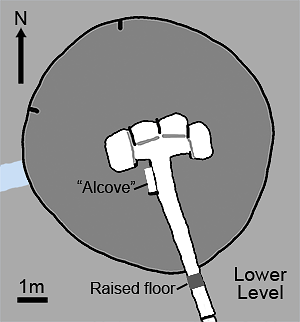
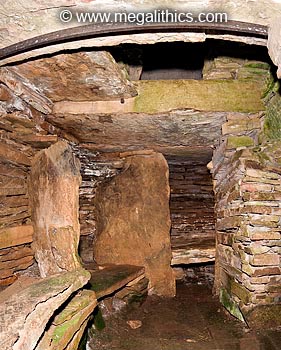 The
lower chamber is situated almost directly beneath the upper, it is slightly
smaller and completely
subterranean, being built in a space that was excavated into hillside. The
disparity in size between the chambers allows the upper chamber walling to
be mainly built upon the solid edges of the pit dug for the lower. The
entire interior of the lower chamber and passage is lined with masonry,
Grant discovered that distance of the outer face of the masonry from the rock or
clay behind varied from 0.25m in the chamber and up to 0.6m in the passage side walls.
Any voids between the masonry and the rock were filled with stones.
The
lower chamber is situated almost directly beneath the upper, it is slightly
smaller and completely
subterranean, being built in a space that was excavated into hillside. The
disparity in size between the chambers allows the upper chamber walling to
be mainly built upon the solid edges of the pit dug for the lower. The
entire interior of the lower chamber and passage is lined with masonry,
Grant discovered that distance of the outer face of the masonry from the rock or
clay behind varied from 0.25m in the chamber and up to 0.6m in the passage side walls.
Any voids between the masonry and the rock were filled with stones.
The masonry of the chamber is of a high standard, the walls are nearly vertical and there are few signs of corbelling being used. The chamber is around 3.7m long (E-W) and around 1.4m wide (N-S) overall, with a height over the bedrock floor of about 1.5m. The space within the chamber is subdivided into four compartments and a central area by 5 vertically set slabs, three in the north wall of the chamber and two in the south. The two southern slabs are set almost flush with the masonry of the wall but the northern slabs protrude deeply into the chamber space. The southern slabs and the end two northern slabs are set opposite each other forming portals for the two end chambers, these are quite deep spaces with rounded wall profiles. The spaces between the three northern slabs form two much shallower "bench" stalls between them, the masonry at the back of each of these being slightly concave.
All of the compartments were fitted with
slabs that acted as shelves with a height of between 0.3-0.5m above the floor.
The shelves are all supported at the rear by a protruding ledge cut from the
bedrock which can be seen in the clear spaces beneath shelves of the end
chambers. The sides of the shelves are supported by upright slabs and the spaces
below the shelves in the middle two stalls are filled with rock and masonry. The
floor is said to be bedrock, but this may not be accurate in the area near the
inner entrance to the passage (see later).
The original entrance to the lower chamber was a passage which runs away from the chamber to the SE with a slight dogleg to the east. The interior end of the passage starts out at 0.6m wide and 1.2m tall, but gradually contracts along its 5.8m length, becoming only 0.4m wide and 0.6m high at the external opening. The height reduction of the passage is achieved by gradual stepping of the roof lintels along its length.
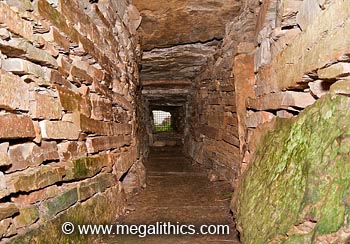 The passage floor is said (6)
to be bedrock for the inner third, but we noticed
what looked like slabs around the inner entrance
area although this could possibly be marks caused by slab removal during the
quarrying of the space, Turner describes the passage as "paved with slabs" and
Grant does not mention the flooring apart from the "blocking " slab (see later).
The final two thirds of the passage is definitely floored with slabs and the
sidewalls appear to be built on these. Around 1.2m from the external opening a
large slab has been set across the passage on the
flooring and forms a "step" 0.2m high, and 0.3m deep, it does not effectively
block the passage and it looks to be part of the original construction as the
ends of the slab are bonded tightly into the masonry of the sidewalls.
The passage floor is said (6)
to be bedrock for the inner third, but we noticed
what looked like slabs around the inner entrance
area although this could possibly be marks caused by slab removal during the
quarrying of the space, Turner describes the passage as "paved with slabs" and
Grant does not mention the flooring apart from the "blocking " slab (see later).
The final two thirds of the passage is definitely floored with slabs and the
sidewalls appear to be built on these. Around 1.2m from the external opening a
large slab has been set across the passage on the
flooring and forms a "step" 0.2m high, and 0.3m deep, it does not effectively
block the passage and it looks to be part of the original construction as the
ends of the slab are bonded tightly into the masonry of the sidewalls.
At present, there are two large slabs set into the west wall of the passage, one is edge set at the base of the wall at the internal opening and the second is set vertically 1.4m from the opening and stands 0.7m tall, neither stone projects significantly into the passage. Burroughs found a recess in the area of the passage sidewall currently framed by these two stones, the recess was 0.5m above the floor, 0.7m long, 0.3m high and 0.4m deep and its southern end was bounded by the upright slab. Davidson and Henshall (6) speculate that this recess was "merely the result of masonry having fallen away", unfortunately the recess cannot be examined today as this section of walling has been rebuilt.
Beyond the last lintel of the roofed section of the passage the sidewalls are continued downhill to the SE for another 5.8m, although much reduced in height. This curious extension gradually narrows in width becoming only 0.06m wide at its end. The section nearest the passage proper was found unroofed for about 1.4m from the final lintel, the southern section however was roofed with miniature lintels, the height beneath them decreasing from 0.2m to 0.06m towards the end. This carefully constructed channel resembles a water course or drain, but it obviously had a different purpose. Undergrowth and silting completely concealed this channel during our visit, so we did not directly observe this feature.
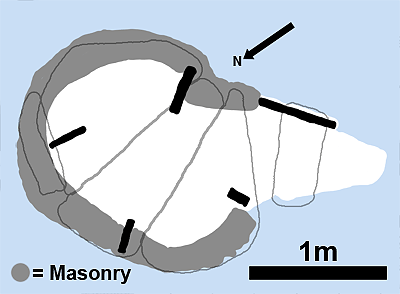
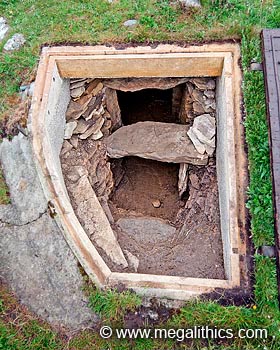 Whilst exploring the limits
of the platform surrounding the cairn, Grant discovered a previously overlooked
small chamber at the SE. This chamber was completely subterranean, being
quarried out of the rock, it measured 1.6m long (SW-NE), and was about 1.1m
wide. The interior is lined with high quality masonry except for a narrow area
at the SW which is interpreted as being the entrance. The masonry is perfectly
vertical with no signs of corbelling and is comprised of tiny slabs, Grant
counted as many as 39 layers of stone in 0.8m of height. Echoing the
upright slabs found in the main chambers, four large slabs are set vertically
into the walling. The chamber is roofed by three large slabs with a smaller slab
inserted under the edge of the eastmost slab, the internal height over the level
bedrock floor is 0.85m.
Whilst exploring the limits
of the platform surrounding the cairn, Grant discovered a previously overlooked
small chamber at the SE. This chamber was completely subterranean, being
quarried out of the rock, it measured 1.6m long (SW-NE), and was about 1.1m
wide. The interior is lined with high quality masonry except for a narrow area
at the SW which is interpreted as being the entrance. The masonry is perfectly
vertical with no signs of corbelling and is comprised of tiny slabs, Grant
counted as many as 39 layers of stone in 0.8m of height. Echoing the
upright slabs found in the main chambers, four large slabs are set vertically
into the walling. The chamber is roofed by three large slabs with a smaller slab
inserted under the edge of the eastmost slab, the internal height over the level
bedrock floor is 0.85m.
The entrance area is a narrow extension to the chamber, its walls are unlined bare rock, the strata at the SW being stepped like a miniature staircase. A lintel is set at a height of only 0.5m here, creating an odd obstacle to entry. The lintel is set into the rock at its northern edge but is supported by an edge-set slab at the south, at only 0.33m wide, the lintel is totally inadequate to seal the entrance, but Grant commented that despite finding only "crude blocking" here, he was surprised that "very little soil had percolated past".
The curious tapering extension to the lower chamber passage mentioned above terminates only 0.6m from the miniature chamber, yet the chamber is not a water filled sump, it was barely damp during our visit, which strongly suggests that the extension was not intended as drainage.
Access to the cairn is by steepish paths over grass, which will prove a problem for wheelchair folk, as will the 0.5m wide entrance passage to the upper chamber. There is no disabled access to the lower chamber as access is by a ladder, see below. There is a parking bay on the road immediately below the cairn. The upper chamber has a circular skylight set in its centre which provides good internal illumination but the lower chamber is a little dark. Access to the lower chamber is via steel ladder through the hole in the centre lintel, the ladder partially blocks the lower chamber when in place but can be removed to allow a full exploration. The miniature subsidiary chamber is covered by a hinged wooden door that is quite heavy to lift and the entrance lintel makes "limbo" access to the tiny interior something for the smaller skinner person only.
When we visited, the upper chamber was home to a hive of bees, it was fascinating to watch the bees emerge from the stonework and rise to the skylight. Each bee would rise up and hover under the skylight for a moment to get its bearings and then descend and fly out through the upper passage, incoming bees headed straight into the stones.
This is the only known double-decker O-C cairn with Bookan-type cells where both chambers are reasonably intact and can be accessed all year round, it should be at the top of the list for the megalithically inclined visitor to Orkney.
1.
The Orcadian,
14th May 1848.
2.
The Orkney Herald, 18th May 1848.
3.
Turner W.,
Proceedings of the Society of Antiquaries of Scotland,
37, p.72-83, 1903.
4.
Grant W. G.,
Proceedings of the Society of Antiquaries of Scotland,
73, p.155-66, 1939.
5. Reynolds D.M. Proceedings of the Society of Antiquaries of Scotland,
115, p.115-124, 1985.
6. Davidson J.L., Henshall A.S. The
Chambered Cairns of Orkney, p160-3, Edinburgh University Press, 1989.